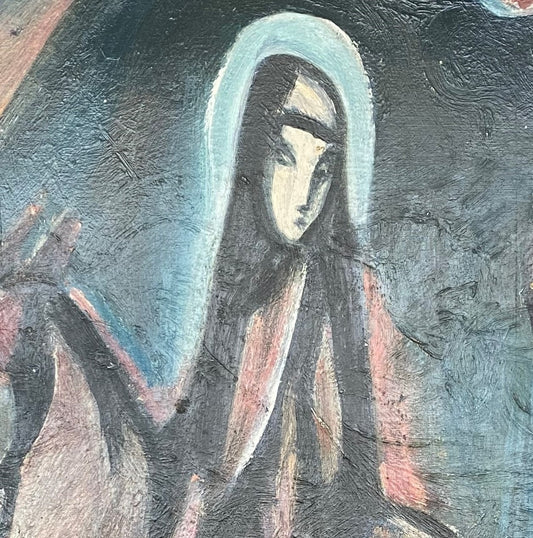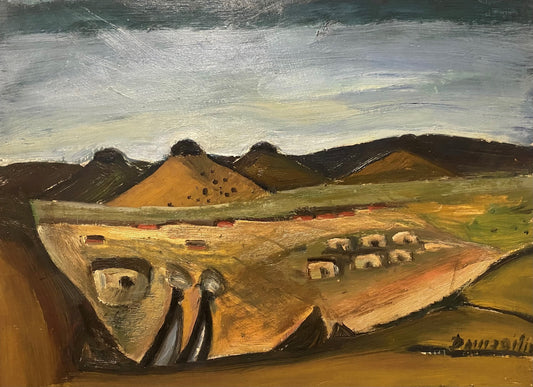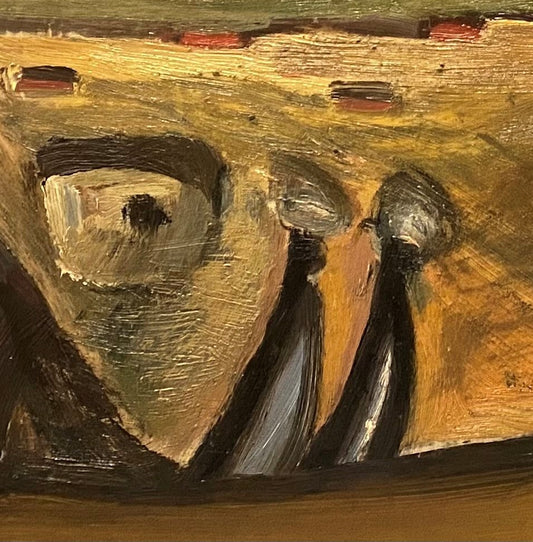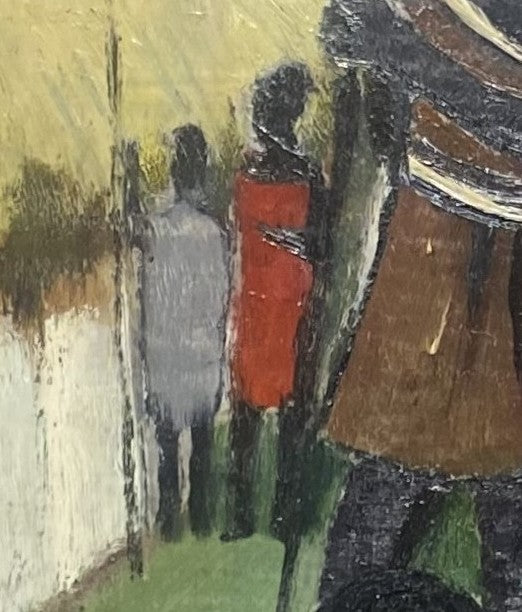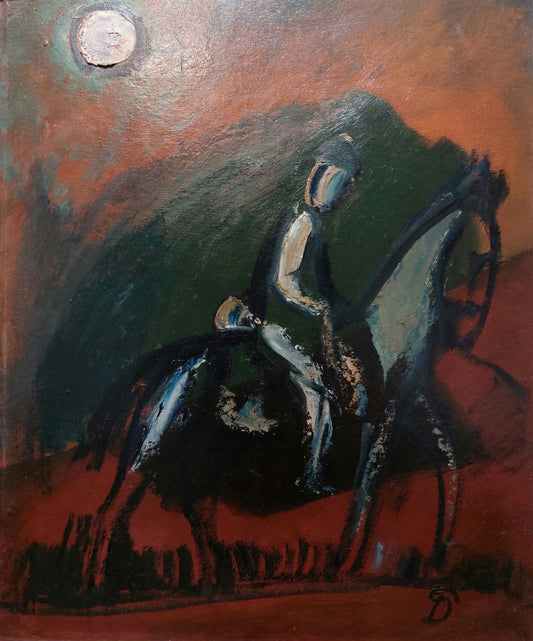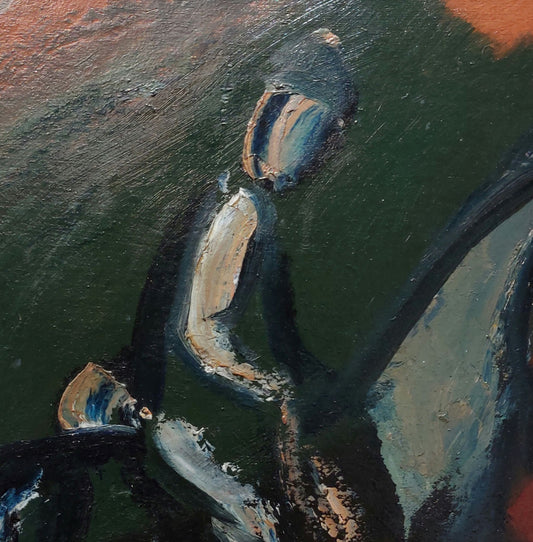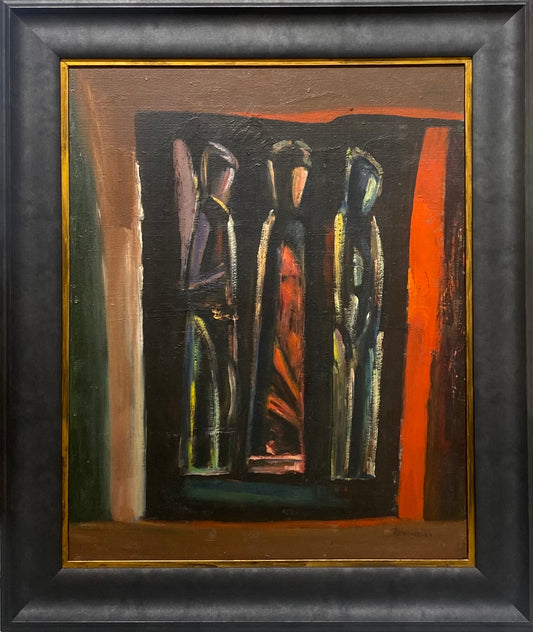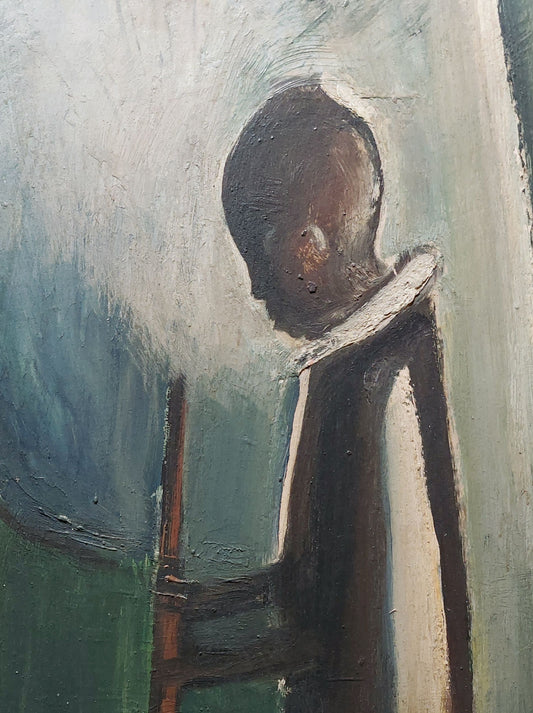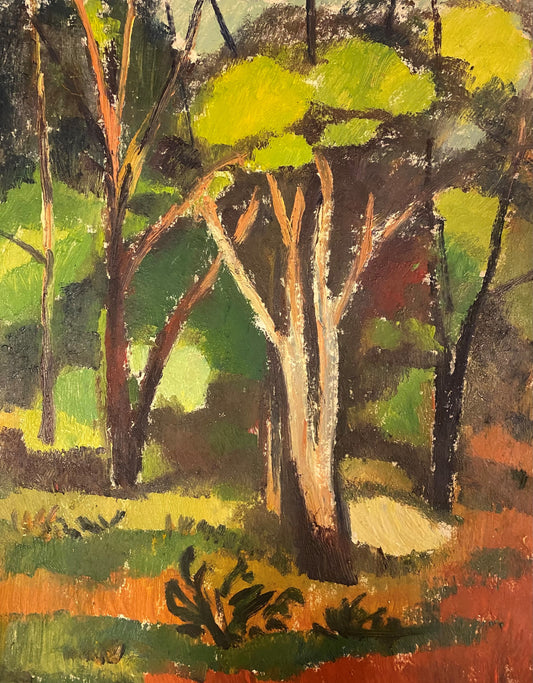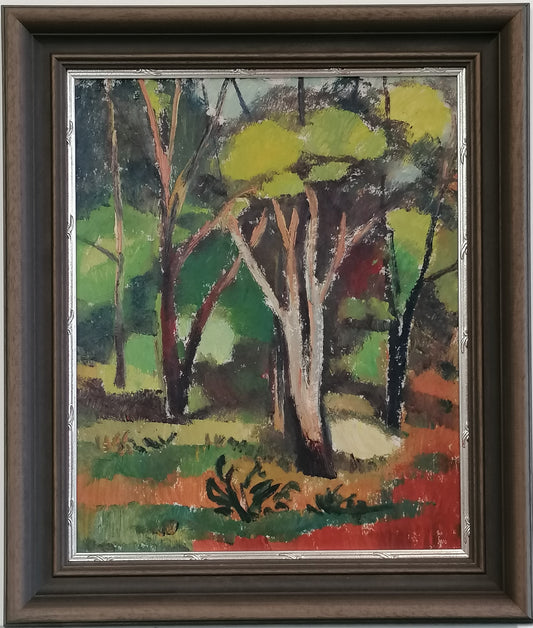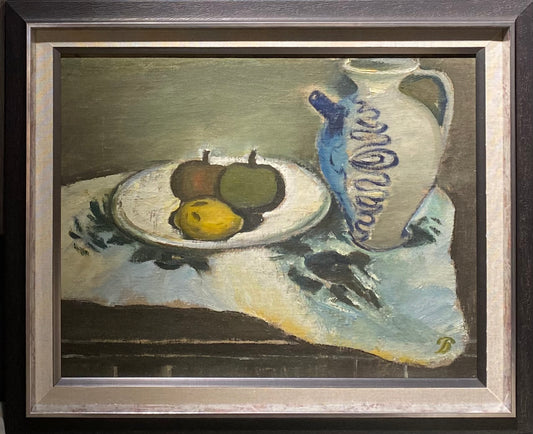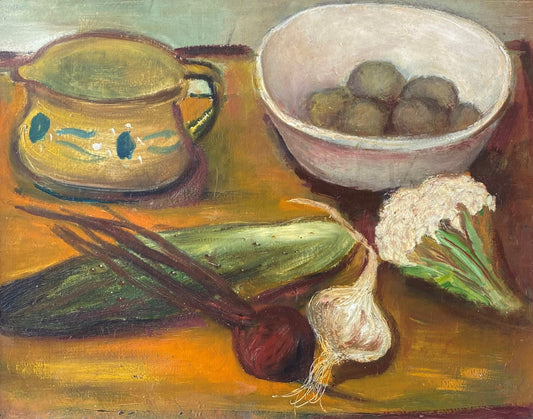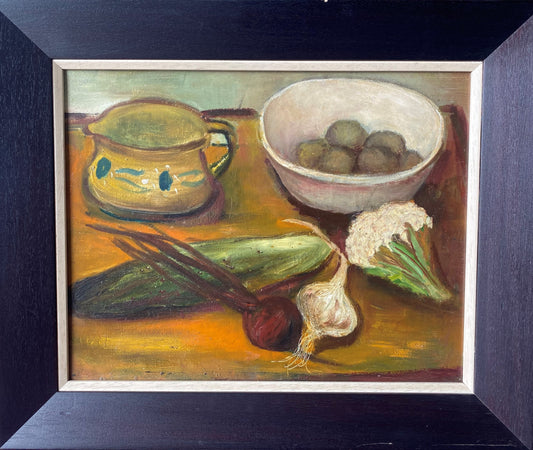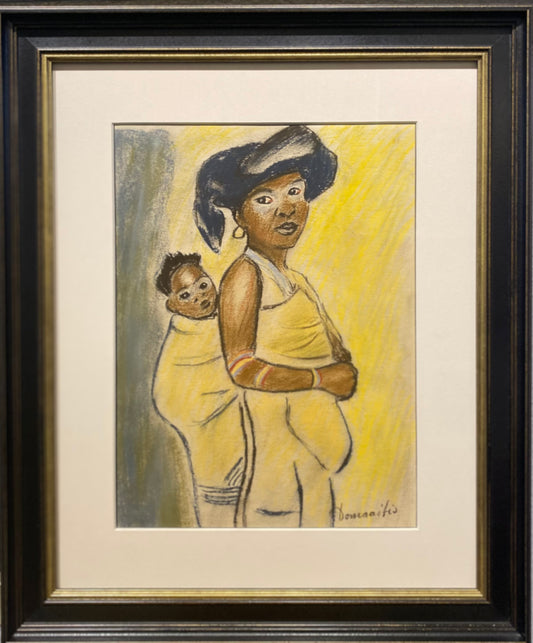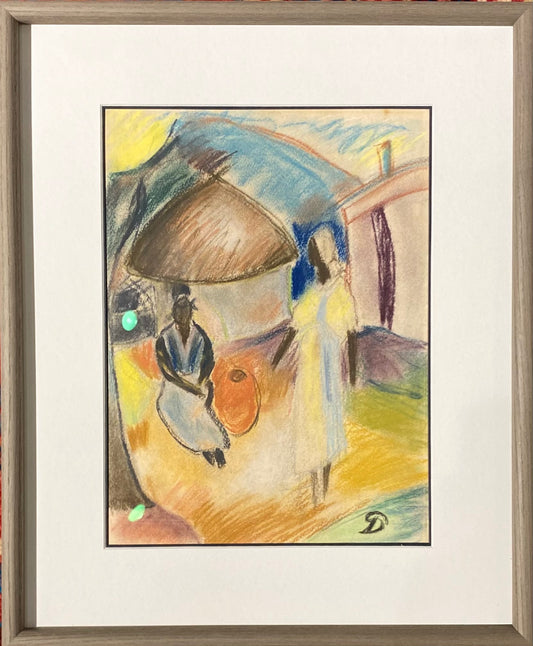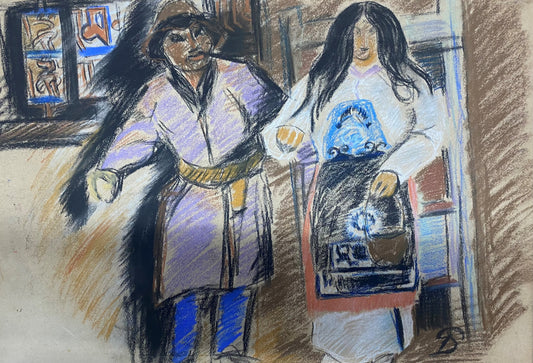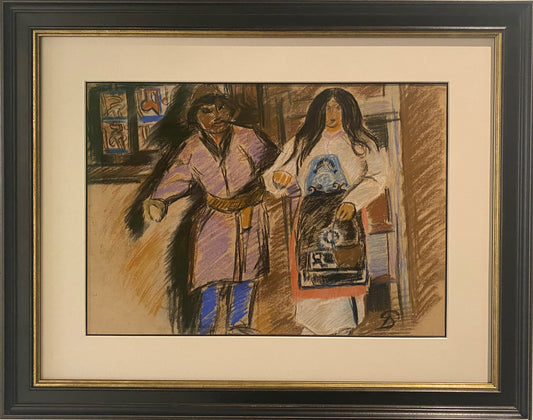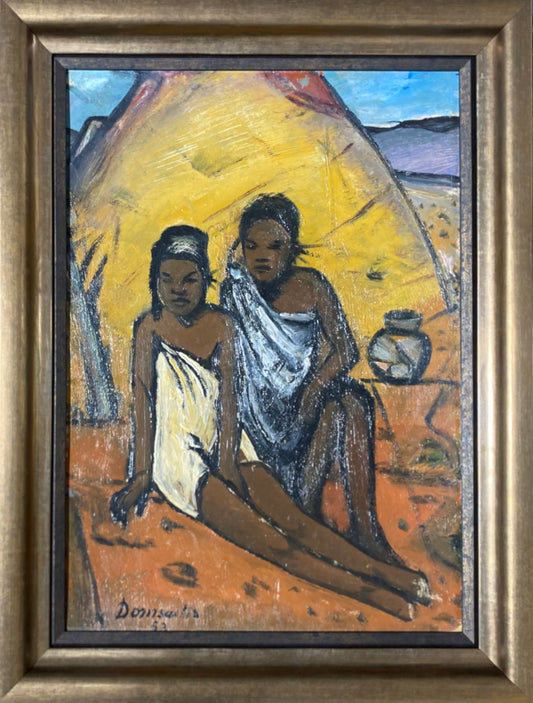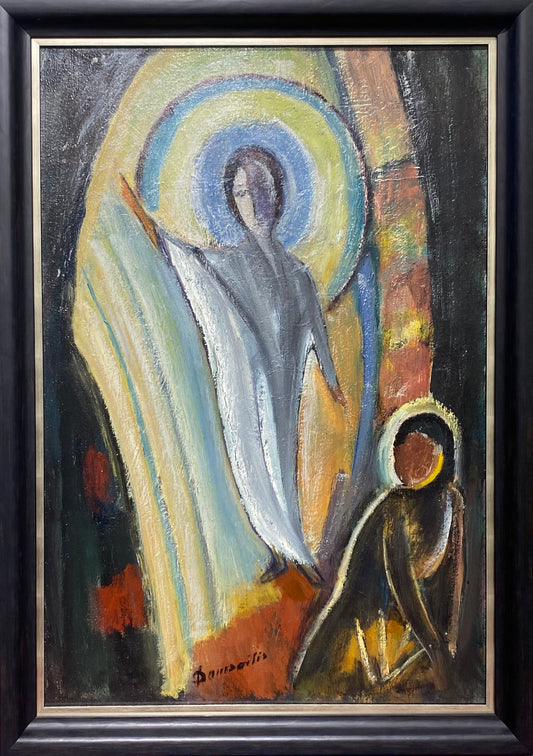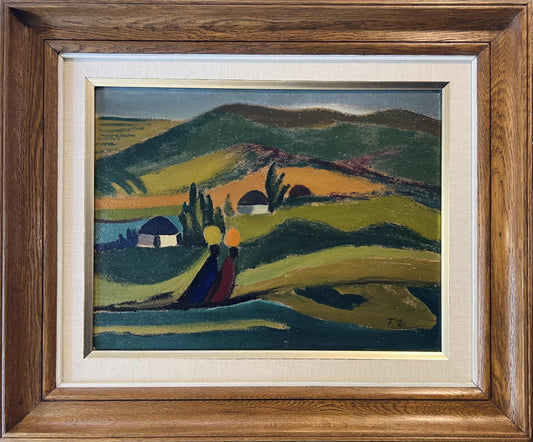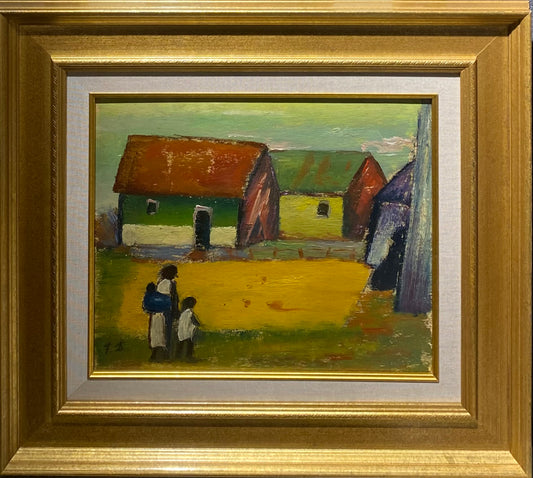Collection: Pranas Domšaitis
PRANAS DOMŠAITIS (1880 - 1965)
Born in 1880 September 15 In the village of Kropiens in East Prussia (Cropiens, Ostpreußen, now Gajevs, Kaliningrad District, Russia), in a family of farmers and worked on his parents' farm until the age of twenty-seven. In 1907, after receiving the recommendation of the famous German artist Max Liebermann, he entered the Royal Academy of Arts, where he studied until 1910. After his studies (1910-1912) he improved in Berlin, in Lovis Corinth's workshop, in Oslo he communicated with Edvard Munch (Munch), for the purposes of his studies he visited famous European museums, participated in the Small Curonian (Klein-Kuhren, now Filin, Kaliningrad sr.) in the activities of the group of artists, 1914-1918. visited the artist colony of Nida. Pranas Domšaitis received recognition in Germany in 1919. having held his first solo exhibitions in Berlin and Breslau. Famous as a creator of landscapes and religious compositions, P. Domšaitis participated in exhibitions together with famous German modernist artists of the time. His works were bought by German state museums and private galleries, and art critics heaped praise on him, calling him a vigorous modernist, a romantic poet, an artist capable of expressing the mystery of people, things and images. German art critic Karlas Šefler (Scheffler) called Mr. Domšaitis's style "spiritual impressionism", and painter Viktoras Vizgirda wrote: "Pranas Domšaitis is an expressionist, perhaps the most prominent and the only one in Lithuanian art, who matured his work in Germany in the environment of this current." surrounded by culture, P. Domšaitis was proud of his Lithuanian origin, was interested in the ancestors of his Lithuanian mother, appreciated Lithuanian folk art, always emphasized the "blood of the distant Baltic Homeland" flowing through his veins. 1920 Having accepted Lithuanian citizenship in Kaunas and received a passport of the Republic of Lithuania, since 1933 the artist signed his works only with the Lithuanian form of his surname - Pranas Domšaitis. The changing times disrupted the successful development of Mr. Domšaitis's work. in 1933 When the Nazi campaign against modern art began in Germany, his work, like that of other Expressionists, was recognized as "degraded", his professional activities were banned, and his paintings were removed from state museums and exhibited in a traveling exhibition of "Degenerate Art" (Entartete Kunst). Forced by necessity, at the end of the Second World War, P. Domšaitis left Berlin for Austria. There he met emigrant Lithuanian artists Telesforas Valių, Paulių Augių and others. He participated for the first time as a Lithuanian artist in the international art exhibitions of emigrants in Austria. in 1949 together with his wife, singer (mezzo-soprano) Adelheide Armhold, the artist went to the Republic of South Africa. The last fifteen years of Mr. Domšaitis' life in Cape Town were extremely productive. The artist traveled around the country, painted a lot, participated in joint exhibitions and held individual exhibitions of his work. His works were quickly recognized by South African art critics and the public, and were gladly bought by museums and private collectors. in 1964 Mr. Domšaitis was awarded the prestigious South African art award "Artists of Fame and Promise". P. Domšaitis died in 1965. Cape Town. in 1978 his widow moved from Cape Town to Hawaii (USA) and organized the first US overview exhibition of Mr. Domšaitis at the University of Hawaii Gallery in Honolulu, which was a great success. 1980-1982 The Lithuanian Foundation (USA) acquired the collection of P. Domšaitis' most valuable works (800 pieces), and in 1989-2001 transferred 530 works of the artist to the Lithuanian Art Museum. in 2001 In the summer, a permanent exposition of P. Domšaitis's work was opened in the Klaipėda Picture Gallery of the Lithuanian Art Museum, in 2004. the gallery is named after Pranas Domšaitis. in 2006 The Lithuanian Foundation decided to transfer another 135 works of the artist to the museum. Currently, 665 works of P. Domšaitis are stored in LDM.
Mr. Domšaitis created oil paintings, pastels, watercolors, prints, and drew. He liked the genres of portraiture and still life, but the most important place in his work belongs to landscape and religious compositions. As early as the 3rd of the 20th century In the 1990s, German art critics called the artist "the hope of contemporary religious art". Starting with realistic images of everyday life, the artist gradually focused on the secrets of human existence, the resolution of his painting became simple and economical. P. Domšaitis saw the meaning of life in creation, and he perceived himself as a mediator who was given the exceptional grace of Providence to express deep, existential things with images and colors. The biblical theme of the "Flight to Egypt" and its interpretations became the leitmotif of the artist's entire life and work. In the image of a road, a journey, we find a reflection of the creator's own troubled life and the experiences of his contemporaries, who experienced the fate of refugees, emigrants, and eternal passengers. "I was always on the road," were the artist's last words. The late works of P. Domšaitis are often compared with medieval art - in the sense of spirituality, immaterial glow of colors and deep symbolism.
Especially meaningful religious compositions. Mystery, reflection of being and religious mysticism dominate not only the plots of "Revelation", "Adoration", "Crucifixion", but also African landscapes. Rhythmic change of plans, hills, trees and houses frozen in eternity, lonely silhouettes moving in the endless fields, beams of light piercing the darkness of the sky - this is already a magical vision of another reality. In P. Domšaitis's work, the experience of European modern art, African art forms, Lithuanian folk worldview and images, 20th century art were combined. echoes of events, reflections on the artist's mission. US art professor Harold Heydon said about P. Domšaitis: "As the ages pass, states and nations remain the most famous for who their artists were and what was the value of their work." Those who can recognize P. Domšaitis as their own are lucky, because even though he was deeply immersed in the eddies of the art currents of his time, he never distanced himself from the traditions of Lithuanian art. Mr. Domšaitis remained a Lithuanian artist, because artists, once mature, carry their nationality with them, wherever they find themselves..." In the history of art, it is a rare case when the majority of works created by an artist are collected in one place. Although the exact number of P. Domšaitis' works is unknown, according to researchers, he could have created up to one and a half thousand works. Today, some of them are lost, some are kept in museums, galleries and private collections in Germany, Austria, Canada, USA, Israel, Australia, South Africa. The National M. K. Čiurlionis Art Museum in Kaunas also has paintings by the artist. The largest collection is stored in the Lithuanian Art Museum. Domšaitis's landscapes are full of not only seriousness and melancholy, but also a hidden refreshing force. They perfectly reveal the character of the vastness of Africa. At the same time, they are symbolic, speaking of universal categories of space and time. It is no coincidence that art historians and critics, when systematizing the image of South African art in encyclopedias, monographs and other publications, always mention P. Domšaitis among the artists who had an influence on the development of art in this country. He was regarded as an artist who successfully combined the experience of European modernism with African art traditions in his work.
Prepared by:
L. Bialopetravičienė, "Pranas Domšaitis", Vilnius: LDM, 2002.
Pranas Domšaitis: the language of figurative painting
Ramūnas Chichelis
www.kamane.lt, 2016-06-14
Semiotics theorist Nijolė Keršytė, in one of the articles dedicated to the problem of the relationship between the theory of semiotics developed by Algirds Julius Greim and phenomenology, states that it is a myth to think that the semiotic concept of language is the opposite of the phenomenological concept of language. In fact, these two types of language complement each other and form a whole.
The theory of semiotics is the fruit of the Russian linguistic formalists of the 19th century. It was further developed by A. J. Graham and Charles Sanders Peirce and their followers in the 20th century in France and the United States, respectively. According to the postulates of the science of semiotics, language is the result of cognition. Any verbal or visual text contains three structural levels: figurative, narrative and logical-semantic. The basis of the figurative level is the unique construction of performers, figures of time and space, which determines the uniqueness and figurative character of the work. The theorists of art studies, when they call a certain type of art "figurative art", they mean the structures of these figures, which are created in the language of painting, sculpture or graphics. The narrative level of the work is more often found in literary works. It consists of four narrative phases: manipulation, competence, performance, and sanction. During the manipulation phase, the textual agent (deity or authority) influences the actants (characters) to pursue an object of value. During a competency, actants experience trials in which they must overcome opponents and obstacles to reach an object of value. In the performance stage, the conjunction of the actant and the object of value occurs (if the competence was successful) or disjunction (if the competence was unsuccessful). In the stage of sanction, the decision-maker evaluates the efforts of the actant, subject, to achieve the object of value and in one way or another rewards or punishes the actant, subject. Such a narrative structure is characteristic of many literary texts. In works of art and especially painting, one narrative stage is recorded or, if a cycle of works of art is created, it becomes possible to recognize and name the stages of the narrative structure and describe them. The basis of the description of the text's logical-semantic structure level is the semiotic square created by A. J. Graham, in the four corners of which logical propositions are arranged according to the relationships of tautology, oppositeness and complementarity. In this way, it is possible to know and describe the structural levels of the work. The work itself, which submits to such a procedure of investigation, in the case of a painting, must be of the type of figurative art.
The semiotic study of works of abstract art is more complex and complicated and concentrates on the elements of the plane of expression. Figurative art maintains a balance between the levels of content and expression.
The phenomenological language of the work and its description is based not only on knowledge, but also on perception. Phenomenological description in principle denies the immanence of the work of art, the principle of independence from the context of creation and the perceiver of art. Phenomenology, being the result of the philosophy of the 20th century, asserts that it is possible to perceive and describe a work only when the perceiver attributes his personal experience to the work of art. It is no longer analysis that dominates, but interpretation. In addition, it is recognized that each work has gaps in structure and content, which the creative reader or viewer fills with their own knowledge and experience. This way of knowing art is also a process of striving for intuition. According to the theories of phenomenology, the perception and description of a work of art is no longer the unfolding of an objective structure, but a subjective and individual process. He needs to prepare himself as an opener in the presence of the Other. Such a relationship with the work of art suggests completely new possibilities for the perception of the work, including the contexts of the perceived creation, the genealogy and the horizons of the perceiver's own expectations - the preconceptions that everyone has when they find themselves in front of a work of painting or encountering a literary text.
Pranas Domšaitis, a Lithuanian artist from the Republic of South Africa in the first half of the 20th century, is undoubtedly a representative of figurative painting. In his works, visual texts, he seeks to know the reality of the country he lives in, which for him is Other, a different experience than Lithuania. Color resolution dominates Mr. Domšaitis's works, the essential and unique sign of his work is a unique color, determined by the reality of PAR. On the figurative level of the works, the performers are local, mostly black people. The artist usually does not choose a big city, a megalopolis, which would not differ in any way from the reality of the USA or Western Europe, but a desert or a suburb, the environment of which is dominated by bright colors. This is the basis of Mr. Domšaitis's landscapes. In works that capture people as well as natural objects, artists and places complement each other. In P. Domšaitis' works, South Africans are so immersed in their environment that they even merge with it. The time of Mr. Domšaitis's works is the current time in almost all of his works. In P. Domšaitis's works, biblical plots are often told, in which the figures of time, combining with the figures of places, affect each other. Time is recognized by place, and vice versa.
The narrative structure of P. Domšaitis' paintings is characterized by the recording of competence and performance stages: the actors of the paintings usually work in their usual living environment, where they have to overcome the challenges that have arisen for them. In those works in which nature is recorded in a landscape way, the performance stage dominates - the very culmination of the action (sea storm, desert evening, etc.). In the biblical paintings, the most characteristic of which is the "Crucifixion", stored in the National Museum of Fine Arts of PAR, the scene of the execution stage is also created. The subsequent supposed resurrection of Christ would already be an expression of the sanction stage. The structures of several narrative stages can already be traced in the diptychs and triptychs. The works of P. Domšaitis created with the motifs of the journey reveal all four stages of the narrative structure.
In the logical-semantic structure of P. Domšaitis's works, the tautology relationship is the most important - the logical elements of the structure of the works do not negate or complement each other, but harmoniously reproduce the integrity of PAR's visual reality. The artist did not seek to shock with contrasts or to create stories close to literary texts, which are developed on the principle of addition between the logical elements of the structure.
P. Domšaitis's painting is expressionist to the extent that at that time the developing art of photography tried the possibilities of expression - capturing the unique light and dark with shading is no less important to P. Domšaitis than subjective creative interpretations. However, for the contemporary viewer of P. Domšaitis's works, the phenomenological relationship with the semiotic structure guided by the goal of cognition, which dominates the works, is more interesting. On the other hand, due to the very limited knowledge of Lithuanians about the life and history of the Republic of Poland's compatriots, P. Domšaitis remains a tool and method of knowledge. Mr. Domšaitis is an author for whom exile was a very new experience, an Other who only became "his" through painting. For a Lithuanian artist, painting is not a therapeutic or interpretative act, but primarily a cognitive act, which, of course, also contains an interpretation based no longer on the Lithuanian culture brought with him, but on the "horizon of expectations" filled with a new reality. As a result of this process, P. Domšaitis's works create the impression that the depicted objects overwhelm the consciousness with color and composition - the author himself and the audience can experience a state of surprise, which is usually not characterized by a prior "horizon of expectations", but rather a lack of it.
-
Pranas Domšaitis | The Flight to Egypt, 1953 | Oil on cardboard, 73x60 (91x78)
Regular price €8.800,00Regular priceUnit price / per -
Pranas Domšaitis | The Hills of the Three Sisters, 1953-55 | Oil on cardboard, 44,5x59 (63x78)
Regular price €7.700,00Regular priceUnit price / per -
Pranas Domšaitis | Africans | Oil on cardboard, 66x47 (75x56)
Regular price €6.000,00Regular priceUnit price / per -
Pranas Domšaitis | The Rider and the Moon | Oil on cardboard, 57x47 (73x63)
Regular price €6.600,00Regular priceUnit price / per -
Pranas Domšaitis | Three Figures | Oil on cardboard, 65x53 (82x69)
Regular price €6.500,00Regular priceUnit price / per -
Pranas Domšaitis | Stamping Maize | Oil on cardboard, 55x40 (73x58)
Regular price €6.800,00Regular priceUnit price / per -
Pranas Domšaitis | Forest in Genadendale, ~1961 | Oil on cardboard, 46x37 (59x50)
Regular price €4.200,00Regular priceUnit price / per -
Pranas Domšaitis | Still life with pitcher | Oil on cardboard, 38x50 (49x60)
Regular price €4.300,00Regular priceUnit price / per -
Pranas Domšaitis | Still life with vegetables | Oil on cardboard, 37x47 (50x60)
Regular price €4.000,00Regular priceUnit price / per -
Pranas Domšaitis | Mother and Child | Pastel, paper, 35x26 (54x45,5)
Regular price €2.000,00Regular priceUnit price / per -
Pranas Domšaitis | Figures outside Huts | Pastel, paper, 38x26.5 (51x42)
Regular price €1.800,00Regular priceUnit price / per -
Pranas Domšaitis | Man and Woman | Pastel, paper, 32x46
Regular price €1.600,00Regular priceUnit price / per -
Pranas Domšaitis | Two Women at the Hut, 1953 | Oil on cardboard, 48x34 (59x45)
Regular price €7.200,00Regular priceUnit price / per -
Pranas Domšaitis | Visitation by an Angel | Oil on board, 82.5x56 (92x65)
Regular price €6.500,00Regular priceUnit price / per -
Pranas Domšaitis | Two figures in a Karoo landscape | Oil, cardboard, 32x42 (49x59)
Regular price €4.000,00Regular priceUnit price / per -
Pranas Domšaitis | Settlement in the Karoo | Oil, cardboard, 30x36 (49x55)
Regular price €0,00Regular priceUnit price / per


